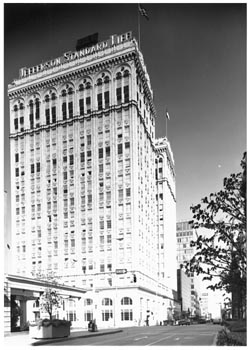| Jefferson Standard Building (1923), Greensboro. By 1970, North Carolina's leading population centers were beginning discernibly to merge. This raised the prospect of a vast, uninterrupted urban complex, a "Charleigh" or "Ralotte" that would pave the tobacco fields of the Piedmont and make parks of its rolling forests. The term "Triangle" was already frequently heard for the Raleigh-Durham-Chapel Hill area, though distinct rural expanses still largely separated the three. "Triad" would soon be coined to designate the Greensboro-Winston-Salem-High Point area, and the term "Metrolina" emerged for the urbanized region of which Charlotte was the hub. All three of these incipient supercities formed points along a 300-mile strip reaching from Lynchburg, Virginia, to Anderson, South Carolina, that seemed likely to become a southern version of megalopolis by the year 2000. At the end of the twentieth century, North Carolina's population exceeded 8 million, and 5.4 million (68 percent) of the state's inhabitants were living in urban areas.
|

